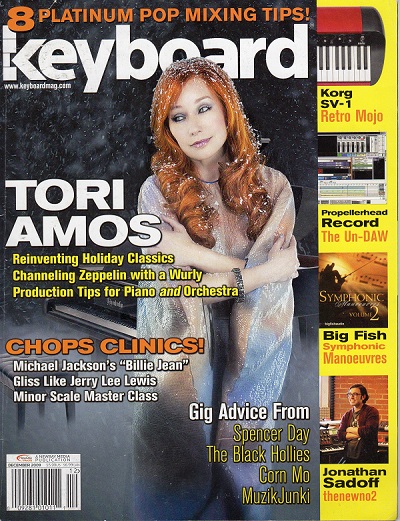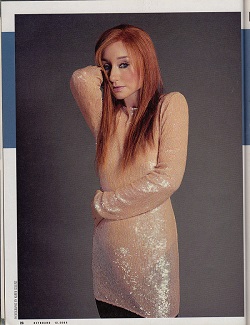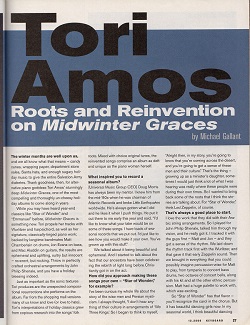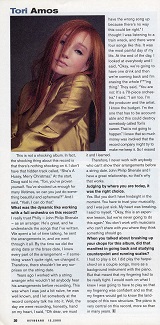|

songs | interviews | photos | tours | boots | press releases | timeline
Keyboard (US)
December 2009

Tori Amos
Roots and Reinvention
on Midwinter Graces
by Michael Gallant
The winter months are well upon us, and we all know what that means -- candy canes, wrapping paper, department store sales, Santa hats, and enough sugary holiday music to give the entire Salvation Army diabetes. Thank goodness, then, for alternative piano goddess Tori Amos' stunningly deep Midwinter Graces, one of the most compelling and thoroughly un-cheesy holiday albums to come along in years.
While you may have heard year-end classics like "Star of Wonder" and "Emmanuel" before, Midwinter Graces is something new. Tori propels her tracks with Wurlitzer and harpsichord, as well as her signature, classically-tinged piano work; backed by longtime bandmates Matt Chamberlain on drums, Jon Evans on bass, and Mac Aladdin on guitars, the results are ephemeral and uplifting, sultry but innocent -- reverent, but rocking. Throw in perfectly crafted orchestral arrangements by John Philip Shenale, and you have a holiday blessing indeed.
Just as important as the sonic textures Tori produces are the unexpected compositional resurrections she performs on the album. Far from the shopping mall versions many of us know and love (or love to hate), Tori's interpretations of holiday classics grew from copious research into the songs' folk roots. Mixed with choice original tunes, the reinvented songs comprise an album as deft and unique as the piano woman herself.
What inspired you to record a seasonal album?
[Universal Music Group CEO] Doug Morris has always been my mentor. I knew him from the mid-'80s when he was chairman of Atlantic Records and broke Little Earthquakes worldwide. He's always gotten what I did and he likes it when I push things. He put it out there to me early this year and said, "I'd like to know what your take would be on some of these songs. I have loads of seasonal records that we put out. I'd just like to see how you would make it your own. You've grown up with this stuff."
We talked about it being beautiful and ephemeral. And I started to talk about the fact that our ancestors have been celebrating the rebirth of light long before Christianity got in on the act.
How did you approach making these songs your own -- "Star of Wonder," for example?
I've been curious my whole life about the story of the wise men and Persian mysticism. I always thought, "I don't hear anything of their culture in arrangements of 'We Three Kings.' So I began to think to myself, "Alright then, in my story, you're going to know that you're coming across the desert, and you're going to get a sense of these men and their culture." That's the thing -- growing up as a minister's daughter, sometimes I would just think a lot of what I was hearing was really where these people were during their own times. So I wanted to bring back some of the roots that I think the stories are talking about. For "Star of Wonder," think Led Zeppelin, of course.
That's always a good place to start.
I love the work that they did with their Arabic string arrangements. So I played for John Philip Shenale, talked him through my vision, and he really got it. I tracked it with the guys first -- Matt and Jon -- and they got a sense of the rhythm. We laid down the rhythm track first with the Wurlitzer, and that gave it that early Zeppelin sound. Then we brought in everything that you could possibly imagine percussion-wise for Matt to play, from tympanis to concert bass drums, two octaves of concert bells, along with his kit and all the other ethnic percussion. Matt had a huge palette to work with, which was exciting.
So "Star of Wonder" has that flavor -- you'll recognize the carol in the chorus. But it has beautiful dancing girls now. In my seasonal world, I think beautiful dancing girls celebrating the rebirth of light -- in the Christian story, the poetry for that is the birth of a baby boy. But the rebirth of light that happens every year has been celebrated by our ancestors for thousands of years and I wanted to capture that.
It makes sense why it's called a "seasonal album," rather than a "Christmas album."
Being brought up as a minister's daughter, this stuff gets hammered into you. It's part of a language of growing up. You just know hymns, no different than if you grow up in a family where both parents are chefs. You're exposed to certain things -- a palette.
Doug talked to me about the idea that so many records are made just upholding arrangements that get passed down. But where do these songs come from? I was driven to think, "Well, wait a minute. If I'm going to do this then I'm part of a tradition and that tradition is variations on the theme." For example, in Britain, "Away in a Manger" is a completely different melody than the "Away in a Manger" that we grew up singing. The reason for some of this is because as denominations were spreading across the Atlantic -- Methodism and all kinds of things -- churches would want to have their own tunes, to separate themselves from other denominations. You've got to work pretty fast to start pulling together carols and hymns if you don't have great composers at your beck and call, and familiarity also plays a part. So they would sometimes use words that people knew and then put tunes from other sources. For instance, "What Child Is This" is from "Greensleeves." Can you imagine writing a religious tune to "Billie Jean"? "Jesus is the Son," instead of "the kid is not my son." So the Brits didn't embrace "What Child Is This" because "Greensleeves" has been a folk song for them for hundreds of years. It was sort of bastardized in their minds by this hijacking.
I use hijacking intentionally because there's a tradition of songs coming from different sources. Sea shanties -- a lot of early hymns come from folk songs. The words would change, and maybe a little bit of the melody, to make it a religious song, because it was a hit and people could sing it. That really fascinated me.
So did you go for true recreations of the original folk tunes?
I can't see what it was in the 1400s but what I can do is make something that has an energy that's a nod to its roots in spirit, and yet comes from our perspective now. So I changed some words because they were changing words in the 1800s, and we have a very different viewpoint. So I'm part of that tradition.
It sounds like you did a tremendous amount of research for this project.
I did. But if I'm honest with you, I did a lot of research not even knowing I was doing it -- just growing up as a preacher's daughter and trying to understand my household. Religion is the center of my parents' lives. There was a burning need my whole life to understand what was happening in other cultures that I hadn't been taught, because it wasn't in the Bible.
So yes, I was driven to find out what was going on in Ireland before Christianity -- their mythology, the mythology in Britain before the Romans came, the mythology in Rome. It was fascinating to see that there were other "gods" that had been born on December 25th before Christianity that were celebrated.
I looked at Doug at one point and said, "Look, I've got my mom, and all this music is so sacred to her." Doug looked at me and said, "Yeah, okay, so you're walking a very thin line. I want less of 'Born is the King of Israel' -- too much of that and I'm going to go crazy, and your mom doesn't want you to be shocking, so you have to please both of us." And I said, "That's a really tall order." And it is. But what I will say is a lot of my classical training came in. This is not a pop record. This is more a classical work. Even though it's contemporary music, I approached it more as a kind of classical study.
What does that mean in terms of your piano playing?
I think it's about structure. I would look at portions of a carol and think, "Wow, this is the magic. Now I need to design around this." So if you think about it like an architect -- they're trying to do this in Bologna, Italy. Bologna's an old, old city and yet they need to add more buildings. It's been really tricky trying to find the architect that can merge the ancient and the new, and what that design would be. That's what I had to do, to work as a musical architect. The classical study that I did for so long, when you're forced to study compositions and the different movements and why they work, helped.
[Studying classical] gives you tools that you don't necessarily get to use all the time when you're in the pop medium. But when you're dealing with something like this and you're treading on very thin ice and sacred ground in some ways, to know that variations on a theme is just part of the classical world [is important], and I enjoy working and composing variations around a theme. You just have to make sure that your variations are as good as the old ones, and you have to know when you don't have it and when you do. I began to see the reactions from the musicians when they were excited. There were also songs that just didn't work.
In our last interview [Keyboard, February '08], you spoke about the different hats you wear in the music creation process. It sounds like what you're talking about now is more the Tori-the-producer role.
Yes, and also Tori the composer. This was really more than an entertainer and singersongwriter project. You really have to walk in and have your chops up to speed as a writer and as a player. Everybody I worked with was really surprised, and all they said was, "We had no idea that this is what it would be." I said, "Well, what did you think it was going to be?" They said, "Well, we didn't know, but not this. This is different." Some of them just thought that they were going to walk in and do what they knew in their heads as a Christmas seasonal record. But they were in there doing all kinds of different rhythms and textures.
This is not a shocking album. In fact, the shocking thing about this record is that there's nothing shocking on it. I don't have that hidden track called, "She's A Hussy, Merry Christmas." At the start, Doug said to me, "Tori, you've proven yourself. You've shocked us enough for many lifetimes, so can you just do something beautiful and ephemeral?" And I said, "Yeah, I can do that."
What was the dynamic like working with a full orchestra on this record?
I really trust Philly -- John Philip Shenale -- as an arranger. He's great, and he understands the songs that I've written. We spent a lot of time talking, he sent the arrangements in, and we went through it all. By the time we did the string date or the brass date, I knew every part of the arrangement -- if something wasn't quite right, we changed it. Therefore, there shouldn't be any surprises on the string date.
Years ago I worked with a string arranger who wouldn't let anybody hear his arrangements before recording. This was when I was just a bit na´ve, he was well known, and I let somebody at the record company talk me into it. Well, the day we were recording, honestly, hand on my heart, I said, "Oh dear, we must have the wrong song up because there's no way this could be right." I thought I was listening to a train wreck, and there were four songs like this. It was the most painful day of my life. At the end of the day, I looked at everybody and I said, "Okay, we're going to have one drink and then we're coming back and I'm erasing the whole f***ing thing." They said, "You are not. It's a 70-piece orchestra." I said, "I am too. I'm the producer and the artist. I know the budget. I'm the one that has to be accountable and this could destroy somebody called Tori's career. That is not going to happen." I knew that so much money was involved that the record company might try to make me keep it. So I erased it and I learned.
Therefore, I never work with anybody who can't show their arrangements before a string date. John Philip Shenale and I have a great relationship, so that's why that works.
Judging by where you are today, it was the right choice.
Yes. But you don't have hindsight in the moment. You have to trust your musicality, and I was just sick. My heart was breaking. I said to myself, "Okay, this is an expensive lesson, but we're never going to do this again." You don't work with musicians who can't share with you where they think something should go.
When you talked about brushing up your chops for this album, did that manifest in going back and studying counterpoint and running scales?
I had to play a lot. I did play the harpsichord on a couple songs, more as a background instrument with the piano. But that meant that my fingering had to be really tight. I would work on what I knew I was going to have to play so that my fingering was confident and so that my fingers would get to know the landscape of this new structure. The piano is very central on this record, more so than in many years.
~ ~ ~
Midwinter Keys, Shifting Registers
"Bösendorfer came down and gave the recording piano this gorgeous makeover," says Tori. "Which was important because you hear the piano a lot on this work, and she shines." The company-lent piano was recorded at Martian Engineering in Cornwall.
While tracking with the piano and her harpsichord, Tori employed a signature keyboard technique. "Sometimes one hand plays on one register and the other on another register, and then that might swap in the 'B' section of a song to other keyboards," she describes. "So you might play Rhodes with the left hand and use the right hand on a different instrument. Then you'd pick that left hand up and play the higher register on the piano, so you're playing possibly a bass configuration with your left hand but on the higher notes. Then your right plays in the mids, maybe around the middle C area. You would never play the same way with your left hand as with your right, so to put it in that higher register, already you're creating new possibilities of tone and rhythm, and the marriage is a unique one. It's a wonderful hybrid creature," she continues. "I use this technique on every record now. In 'Star of Wonder' there's some of that going on."
original article
 
 
[scans by Sakre Heinze]
t o r i p h o r i a
tori amos digital archive
yessaid.com
|